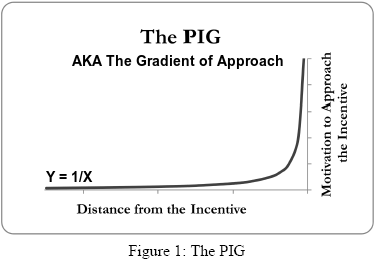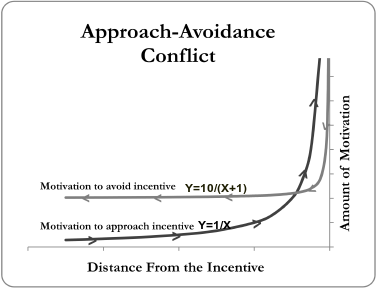No temptation can ever be measured by the value of its object.
— Sidonie Colette
The Problem of Immediate Gratification (the PIG) is our name for the principle that immediate payoffs are far more influential than delayed payoffs—even if the latter is much larger (e.g., choosing $1 now over $10 tomorrow). The other side of the same coin is the tendency to
avoid a small punishment now at the cost of a big punishment later (e.g., avoiding dental treatment).
The relationship between the immediacy of a payoff and the magnitude of its influence is hyperbolic. So when the payoff is close (in terms of time, space, or psychological distance) it can be extremely influential on real-time behavior (see Figure 1).
Some outcomes such as physical health, professional success, or loving relationships may have a large magnitude but are not produced immediately by a specific behavior. In contrast, the gratification produced by your incentive of choice is immediate, and for that reason exerts an influence on subjective phenomena [e.g., motivation, distortion of appraisals] that is disproportional to its magnitude or importance.
Some people are more impulsive than others and hence are particularly vulnerable to the PIG. Even if you are not generally impulsive, the PIG is worthy of your respect.
Understand this: Subjective phenomena, including your appraisals and response tendencies, will be distorted in ways that you cannot now imagine when the
incentive is nearby. Choices that may seem ridiculous now may seem like a
good idea then.

An approach-avoidance conflict occurs when a course of action produces both costs and benefits. The PIG doesn’t care which is bigger or more important, he is only interested in which comes first.

Above is a representation of the conflicting motivations of an approach-avoidance conflict in which the darker line indicates the attractive motivation pulling you toward the incentive, and
the lighter line represents the repellant motivation pushing you away from the incentive. In this example the punishment is ten times greater than the reward but delayed by one unit of time.
When you are far from the incentive, the repelling force is greater than the attractive force. But when the incentive is near, the PIG works its magic and the pull of the incentive becomes very strong very quickly. Once the gradients cross and the motivation to approach is greater, there is nothing to stop relapse. In fact, the loss of control can happen so fast that you may not see it coming.

that is, the motivation to approach the incentive minus the motivation to avoid it.
Imagine a magnet slowly approaching an iron bar. When the magnet is far away the forces holding the bar in place [friction and inertia] are greater than the attractive pull, so there is no movement. As the magnet approaches it comes close enough to cause the bar to move slightly. Once it starts to move toward the magnet, positive feedback produces a dramatic acceleration and its merger with the magnet is nearly instantaneous.
When you are far from the incentive, the gradient of net attraction is below zero indicating motivation to avoid the incentive. In this psychological state you will feel certain that there is no danger of relapse. Note that the motivation to lapse is relatively flat until it crosses the line of equilibrium.
But as you approach the incentive — in terms of time, space, or psychological distance, its influence on subjective phenomena [motivation, appraisals, response tendencies] increases so rapidly that you may lapse before you know it. There may be no internal debate,
no attempt to override the urge; you may simply go from intending not to lapse to lapsing in the blink of an eye — without making a conscious decision to do so. Because the PIG is a stealthy trap that springs into action so quickly it is important to be vigilant. As soon as you become aware of early warning signals it is urgent that you put distance between you and the incentive.